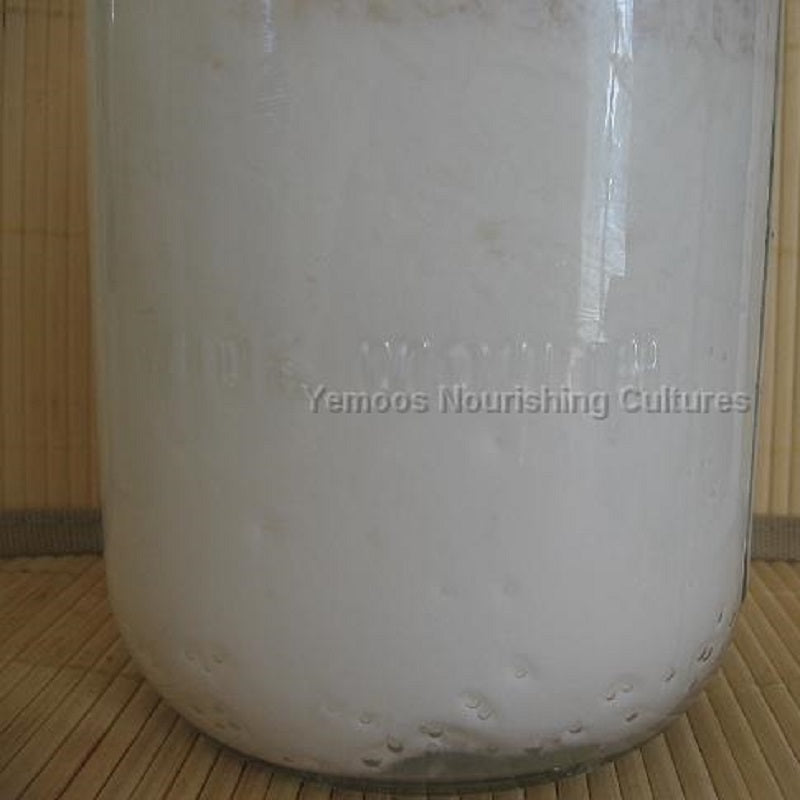
Generally most people desire to keep their milk kefir bacteria rich instead of yeasty. The yeast is responsible for the effervescent and multi-dimensional qualities, so its definitely important, but too much and its becomes less appealing.
Yeasty kefir will ferment fast, fizzy and thin.

Milk kefir has a tendency to slowly shift towards the yeast if its not under ideal conditions. But there are ways to help shift the balance in favor of the bacteria.
1. Use Raw Milk
Raw milk is filled with good bacteria (and enzymes) and that means its very hard for the yeast to take over no matter what you do. I've never seen raw milk kefir go the yeasty route. It's the most fool proof way to keep it bacteria rich, slow and usually thick. Granted that in many states and countries, it is very different to locate a good quality raw milk. Raw milk kefir is best, but pasteurized milk kefir is still a very healthy alternative. So if you go the pasteurized route there are still ways to keep it as bacteria rich as possible by following the rest of the list.
2. Ferment Colder
Try consistently fermenting the kefir at 65-70 degrees. The slightly cooler temperatures favor a slower more bacteria rich ferment.
Avoid temperatures below 65 if possible as it can sometimes cause an improper ferment.
Also avoid temperature fluctuations. Fluctuations stress out the kefir and when the grains get stressed, the yeast tends to take over as the yeast is faster and more opportunistic than the bacteria.
3. Use more milk
Over-fermentation can stress out the grains and any stress can lead to yeasty grains. Using more milk will help naturally balance the grains. The yeast tends to be faster and more opportunistic, so if there's not enough milk, it can steal the needed nutrients and sugars and not leave much for the bacteria to thrive on. With plenty of milk, there should be enough for both the bacteria and yeast.
4. Ferment longer than 24 hours
Grains can adapt to longer schedules and this will ultimately help the bacteria. If you do consistent 48-72 hour batches, It will adapt to this new schedule and will ferment slower, more bacteria rich and many times thicker. Longer ferments naturally help the bacteria as it tends to be slower than the yeast and it takes time for the bacteria to catch up to the yeast. If you are continually doing short ferments, the yeast can sometimes continually have the upper hand.
5. Bury the grains in yogurt technique

Simply bury the grains in a jar of plain yogurt for a few days in the fridge. The idea behind this technique is that yogurt is rich in bacteria with little to no yeast and that environment will help shift the balance from yeasty to bacteria rich. I've heard mixed results from this technique. Sometimes it works great, but may not be aggressive enough if the grains are really yeasty.
6. Occasional long ferment technique
This technique tends to help to some degree and can be done multiple times for better results. Basically the idea is to do the occasional 2-3 day ferment and it will naturally over-ferment, but in that environment the bacteria has a chance to catch up to the yeast and the yeast tends to calm down a bit. When you go back to the regular 24 hour schedule, it tends to be slower and more bacteria rich. I've seen grains that refused to grow because of the yeasty environment, start growing again after doing this technique. You can do this technique a couple times, but its best not to continually over-ferment them as that will stress them out.
7. Fridge Ferment
Ferment exclusively in your fridge to help calm the yeast and keep it bacteria rich. It takes about a week but can vary with different fridge temperatures. Most people notice that its gets thicker too. Sometimes if the grains are really yeasty, it can stay that way even in the fridge. One aggressive trick is to give the grains a really good rinse and then ferment in the fridge.
8. Aggressive rinsing and resting
This technique should only be done as a last resort. The aggressive rinsing and resting will rinse away beneficial surface bacteria and yeast that the grains will have to rebuild which can take several batches. Basically you simply rinse the grains really well in unchlorinated water and leave them in in fresh unchlorinated water for 2-3 days. A less aggressive form on this technique is to let them rest in milk for 2-3 days.



Comments
Yemoos Nourishing Cultures
Hi Kathy, store bought kefir has more in common with regular yogurt than it does with home-made kefir. Typically they share a couple bacteria strains with kefir, but that’s about it. They do not use grains, but rather they use a few strains of bacteria and typically no yeast strains. Home-made kefir is rich with a diverse number of bacteria and yeast strains naturally balanced. It should be slightly fizzy as there is yeast, but it should still be pleasant. If its overly fizzy, then try a cooler spot. Raw milk and cool temperatures should calm any yeast issues.
July 29, 2019
Kathy
Hi,
I am just started to making kefir, so the 3rd time is my kefir still a bit fizzy, and a bit sour. It doesn’t like what I bought in the shop. What did I do wrong? I am using raw full cream milk, and fermenting it for 24-36 hrs. Pls help .
July 29, 2019
Yemoos Nourishing Cultures
Hi Su Y – Unfortunately long term storage in the fridge can sometimes result in grains that still ferment, but stop growing. Sometimes there’s nothing you can do to get them to grow again. Your best option is to nourish them with plenty of milk and space. Try for slower, cooler and longer ferments and it will help balance them and give them the best chance to thrive again. You can also try cutting the grains up a bit to expose new surface area and that may possibly allow for new growth.
June 14, 2019
Su Y
I was given mk grains last August which I kept in the fridge until February the following year. Having started fermenting the mk grains since February this year, I realised my mk grains have not multiplied. I have tried 1F outside at room temp. for 12 hrs, then bringing in the bottle of mk grains into the fridge for another 12 hrs. That resulted in over-fermentation. So I left the mk grains in 500ml of greek yoghurt for a week to nourish it. As I live in a tropical climate, I am finding that my mk grains now seem to ferment quite fast and the grains seem to be getting finer. I was told to strain my grains after 1F if I intend to continue with 2F but the size of the grains have not improved. How can I get the mk grains to multiply?
June 14, 2019
Jacques M
Sometimes my water kefir ferments “yeasty, fizzy” but I like the fizzy touch of yeast taste. Is it okay to drink a yeasty kefir ferment? Also, after you separate the kefir grains, how long can you store the fermented kefir to drink?
March 05, 2019
Richard K Remmen
I always keep a quart jar of milk covered grains in the fridge. I make kefir every day by removing the cold grains I need from the fridge grains and adding to a jar of milk on a kitchen counter. After a 24h culture I do the usual strain out of the grains from the finished kefir and then mix the grains back into the fridge jar. Then I take out some of the grains from the grain mixture in the fridge jar for starting another batch of kefir. Every couple days I strain out the fridge grains (the cover milk turns into good kefir after two days) and add fresh milk to the grains in the fridge jar. This keeps the grains healthy and gives me consistently excellent kefir.
January 26, 2019
David
I have heard several methods (often contradictory) about how to fix yeasty grains. One group says yeast does fine in cold but Bacteria nearly goes to sleep, so fridge ferment nudges it toward yeasty. They recommend raising temp to 74-76 deg. F to let the Bacteria outpace the yeast. This makes sense to me as my frozen yeast rolls I let thaw in my fridge rose just fine, while a fridges entire purpose for existing is to slow down Bacteria! What I do (whenever I screw them up) by over fermenting or whatever, is strain off only the grains I need for the next batch, then press the remaining grains through the strainer into the Kefir I put into the fridge for the next day. Even if the original batch smelled yeasty, by the next day all the yeasts food is gone and the Kefir is nice and thick! I also put my grains in a clean jar with just a little fresh milk, shake well, strain and discard milk. repeat. then do a regular batch…My grains love it!
June 08, 2018
Mary Bergey
My kefir grains are yeasty. I use raw milk and the resulting ferment tastes like strong cheese. It’s not drinkable. If I soak the grains in yogurt, should that be done in the refrigerator or on my kitchen counter and for how long? Thanks for any help you can offer.
December 16, 2018
Carl
Switching to grass fed milk made a big difference. I like the smooth texture and rich mouthfeel, even though it is two percent milk fat. Might ferment a bit slower. Love Kefir. Digestion issues all gone.
May 03, 2018
Lauren Jachimowicz
I received some kefir grains from a friend. The kefir is thickening but it smells rancid and not sour at all. Is there something wrong with the grains? Do I just need to get them more bacteria rich? Throw them out?
November 09, 2017
Leave a comment